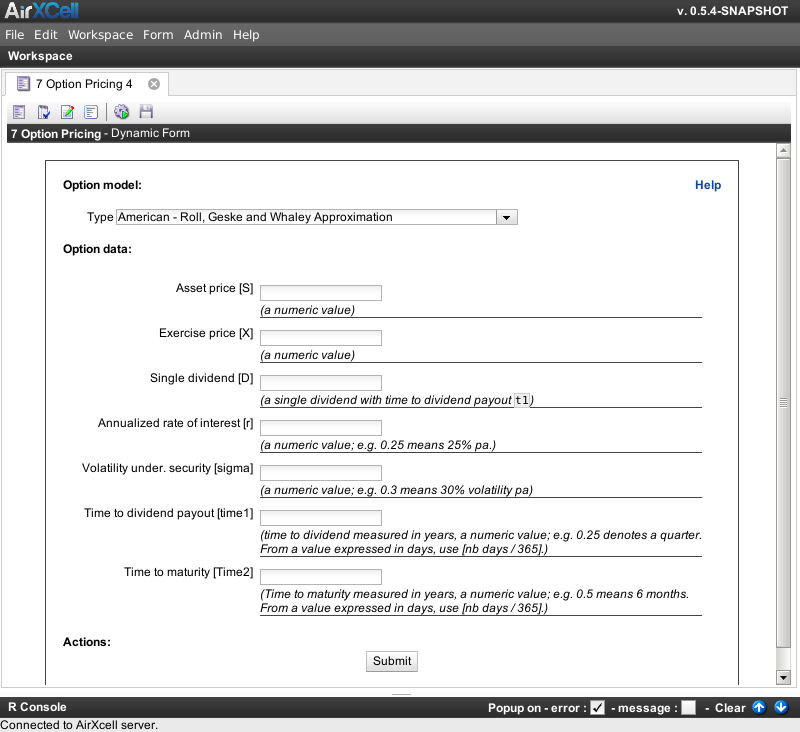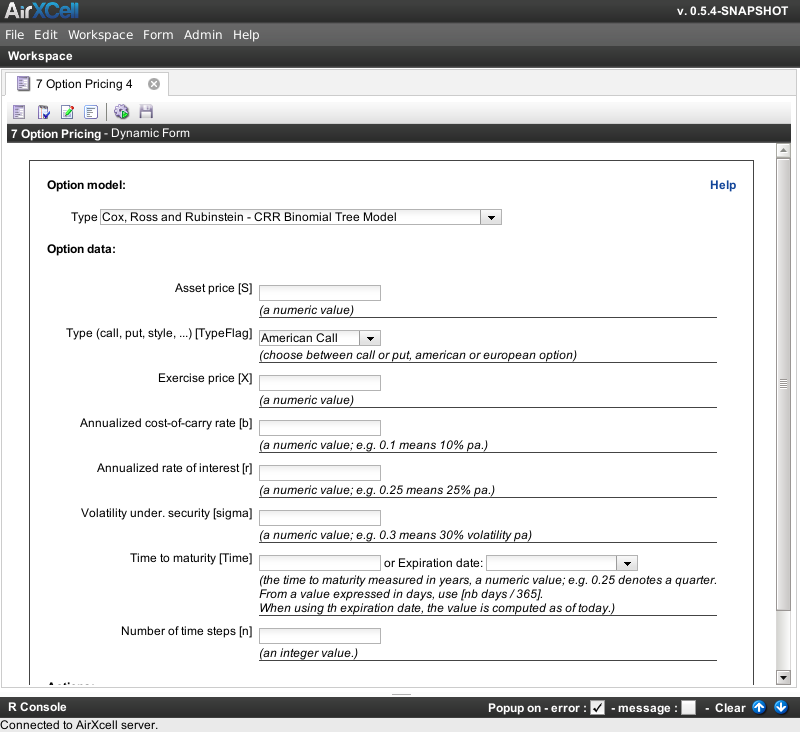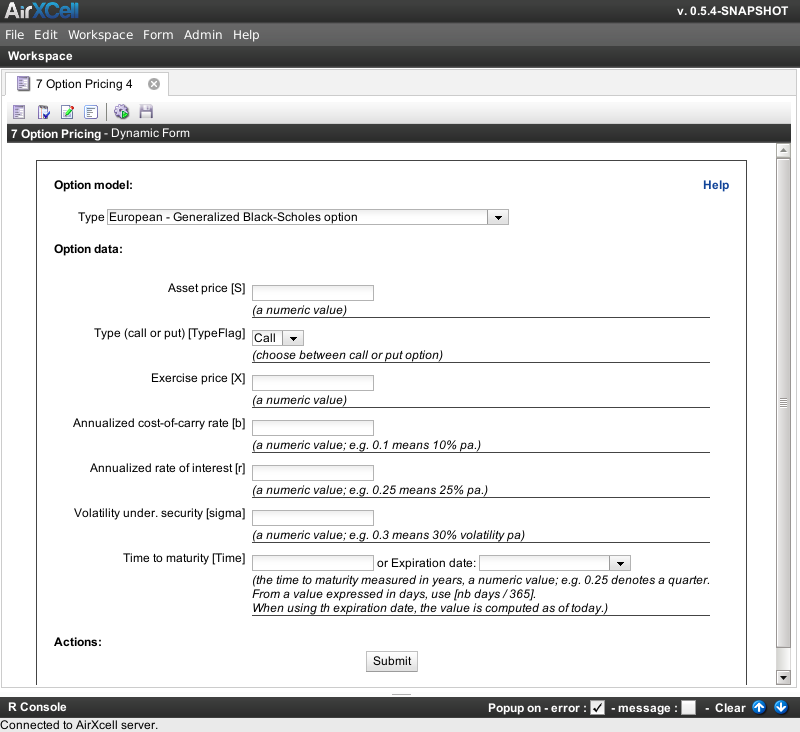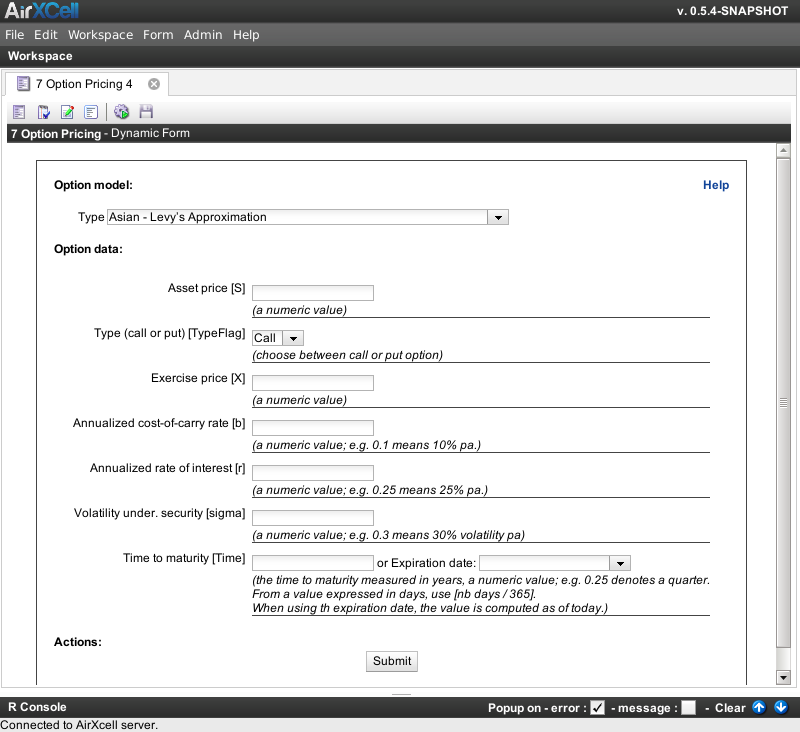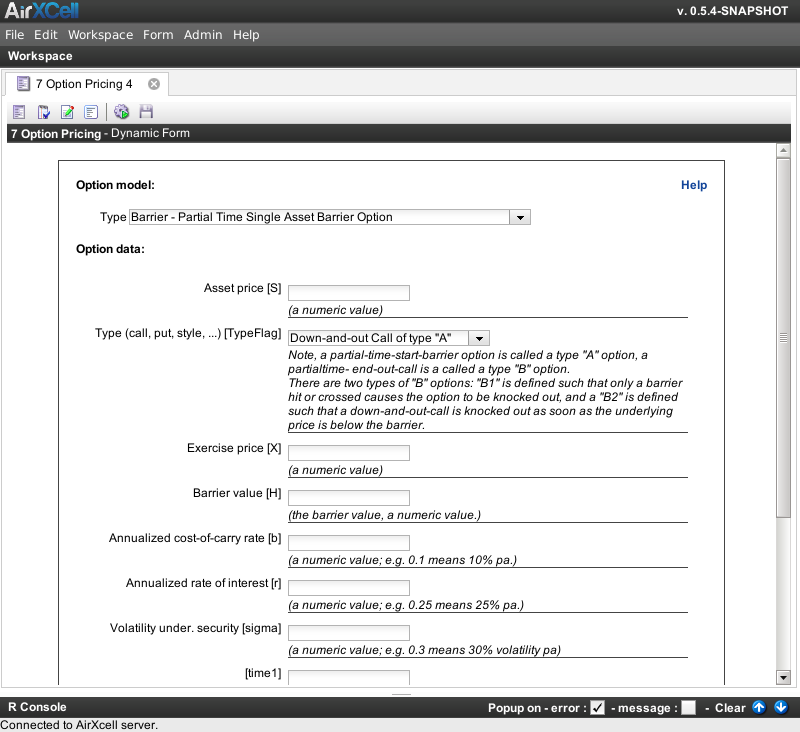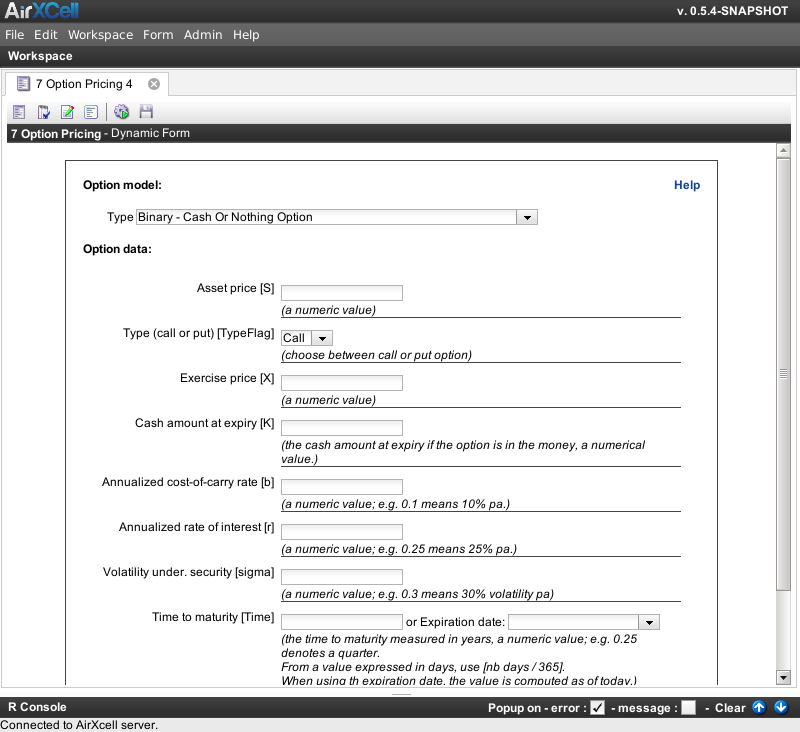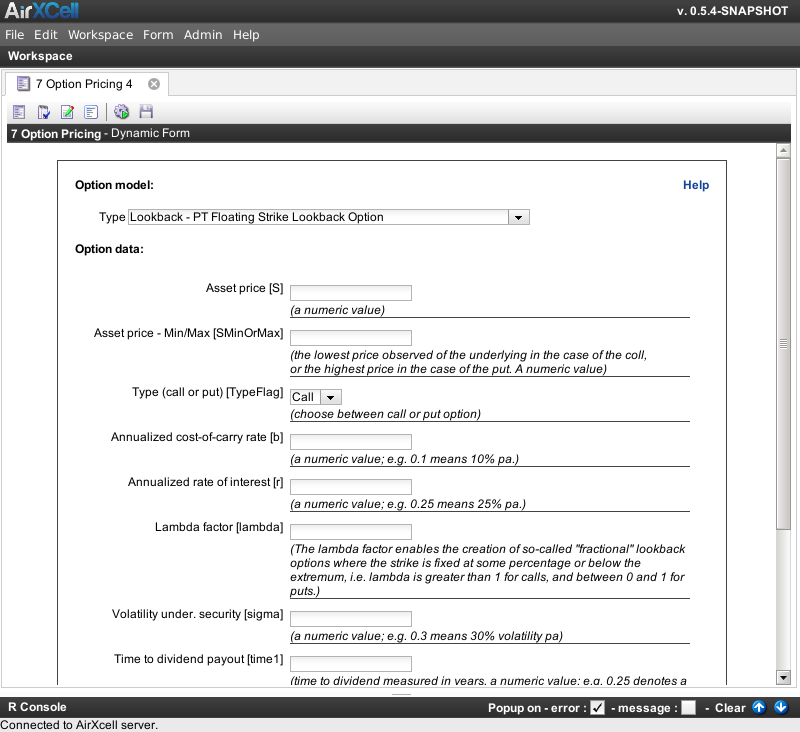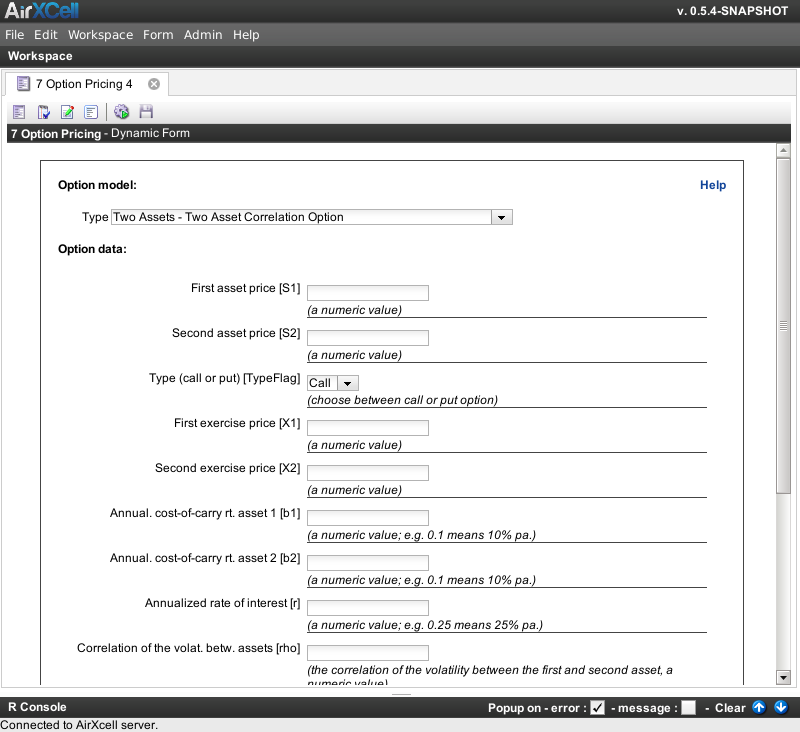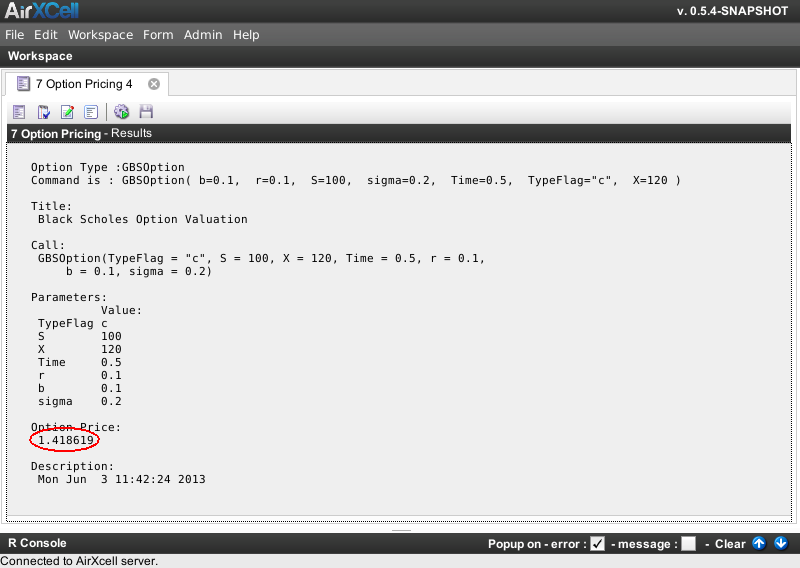Copyright © 2011-2014 airxc.com, airxcell.com
Table of Contents
This dynamic form is about option pricing / option valuation. It provides the user with a mean to perform online option pricing / option valuation following most of the basic and exotic models:
- american options,
- european options,
- asian options,
- barrier options,
- binary options,
- curency translated options,
- looback options,
- multiple assets options and
- multiple exercises options.
A new "7. option pricing" form can be added to the workspace by using
Form → 7. option pricing
(![]() )
)
Quoting wikipedia : In finance, an option is a derivative financial instrument that specifies a contract between two parties for a future transaction on an asset at a reference price (the strike).[1] The buyer of the option gains the right, but not the obligation, to engage in that transaction, while the seller incurs the corresponding obligation to fulfill the transaction. The price of an option derives from the difference between the reference price and the value of the underlying asset (commonly a stock, a bond, a currency or a futures contract) plus a premium based on the time remaining until the expiration of the option. Other types of options exist, and options can in principle be created for any type of valuable asset.
An option which conveys the right to buy something at a specific price is called a call; an option which conveys the right to sell something at a specific price is called a put. The reference price at which the underlying asset may be traded is called the strike price or exercise price. The process of activating an option and thereby trading the underlying asset at the agreed-upon price is referred to as exercising it. Most options have an expiration date. If the option is not exercised by the expiration date, it becomes void and worthless.
In return for assuming the obligation, called writing the option, the originator of the option collects a payment, the premium, from the buyer. The writer of an option must make good on delivering (or receiving) the underlying asset or its cash equivalent, if the option is exercised.
An option can usually be sold by its original buyer to another party. Many options are created in standardized form and traded on an anonymous options exchange among the general public, while other over-the-counter options are customized ad hoc to the desires of the buyer, usually by an investment bank.
Because the values of option contracts depend on a number of different variables in addition to the value of the underlying asset, they are complex to value. There are many pricing models in use,
The value of an option can be estimated using a variety of quantitative techniques based on the concept of risk neutral pricing and using stochastic calculus. The most basic model is the Black–Scholes model. More sophisticated models are used to model the volatility smile. These models are implemented using a variety of numerical techniques. In general, standard option valuation models depend on the following factors:
- The current market price of the underlying security,
- the strike price of the option, particularly in relation to the current market price of the underlying (in the money vs. out of the money),
- the cost of holding a position in the underlying security, including interest and dividends,
- the time to expiration together with any restrictions on when exercise may occur, and
- an estimate of the future volatility of the underlying security's price over the life of the option.
More advanced models can require additional factors, such as an estimate of how volatility changes over time and for various underlying price levels, or the dynamics of stochastic interest rates. More informations on options are for instance available on [14].
This section presents the models implemented within AirXCell. Most models come from the rMetrics fOptions and fExitocOptions R packages.
American options can be exercised anytime during its life. Since investors have the freedom to exercise their American options at any point during the life of the contract, they are more valuable than European options which can only be exercised at maturity.
For instance, the Option pricing dynamic form using a american option model - here the Roll, Geske and Whaley Approximation - looks as follows: Figure 16.1, “American option pricing example”.
The supported models for american options are as follows:
This consists in valuating American calls on a stock paying a single dividend with specified time to dividend payout according to the pricing formula derived by Roll, Geske and Whaley (1977).
Parameters are:
This valuates American calls or puts on an underlying asset for a given cost-of-carry rate according to the quadratic approximation method due to Barone-Adesi and Whaley (1987).
Parameters are:
This valuates American calls or puts on stocks, futures, and currencies due to the approximation method of Bjerksund and Stensland (1993).
Parameters are:
The Binomial Options Pricing Model (BOPM) provides a generalizable numerical method for the valuation of options. The binomial model was first proposed by Cox, Ross and Rubinstein (1979). Essentially, the model uses a discrete-time (lattice based) model of the varying price over time of the underlying financial instrument.
The Binomial Options Pricing Model approach is widely used as it is able to handle a variety of conditions for which other models cannot easily be applied. This is largely because the BOPM is based on the description of an underlying instrument over a period of time rather than a single point. As a consequence, it is used to value American options that are exercisable at any time in a given interval.
For instance, the Option pricing dynamic form using a binomial option model - here the Cox, Ross and Rubinstein, CRR Binomial Tree Model - looks as follows: Figure 16.2, “Binomial option pricing example”.
The supported variations of the binomial model are as follows:
Binomial models were first suggested by Cox, Ross and Rubinstein (1979) (CRR), and then became widely used because of its intuition and easy implementation. Binomial trees are constructed on a discrete-time lattice. With the time between two trading events shrinking to zero, the evolution of the price converges weakly to a lognormal diffusion.
Parameters are:
There exist many extensions of the CRR model. Jarrow and Rudd (1983), JR, adjusted the CRR model to account for the local drift term. They constructed a binomial model where the first two moments of the discrete and continuous time return processes match. As a consequence a probability measure equal to one half results. Therefore the CRR and JR models are sometimes atrributed as equal jumps binomial trees and equal probabilities binomial trees.
Parameters are:
Tian (1993) suggested to match discrete and continuous local moments up to third order.
Parameters are:
An option that can only be exercised at the end of its life, at its maturity. European options tend to sometimes trade at a discount to its comparable American option. This is because American options allow investors more opportunities to exercise the contract.
European options normally trade over the counter, while American options usually trade on standardized exchanges. A buyer of an European option that does not want to wait for maturity to exercise it can sell the option to close the position.
For instance, the Option pricing dynamic form using the generalized black-scholes model looks as follows: Figure 16.3, “European option pricing example”.
This consists in computing the option price following the Generalized Black scholes method.
Parameters are:
For Asian options the payoff is determined by the average underlying price over some pre-set period of time. This is different from the case of the usual European option and American option, where the payoff of the option contract depends on the price of the underlying instrument at exercise; Asian options are thus one of the basic forms of exotic options.
One advantage of Asian options is that these reduce the risk of market manipulation of the underlying instrument at maturity. Another advantage of Asian options involves the relative cost of Asian options compared to European or American options. Because of the averaging feature, Asian options reduce the volatility inherent in the option; therefore, Asian options are typically cheaper than European or American options.
For instance, the Option pricing dynamic form using a asian option model - here the Levy's Approximation - looks as follows: Figure 16.4, “Asian option pricing example”.
The supported models for asian options are as follows:
This uses the geometric average-rate option. The geometric average is the nth root of the product of the n sample points. Although Geometric Asian options are not commonly used in practice, they are often used as a good initial guess for the price of arithmetic Asian options
Parameters are:
This uses the arithmetic average-rate option. The arithmetic average is the sum of the stock values divided by the number of sampling points. Here we ae using Levy's approximation.
Parameters are:
A barrier option is an exotic derivative (here an option) on the underlying asset whose price breaching the pre-set barrier level either springs the option into existence or extinguishes an already existing option.
For instance, the Option pricing dynamic form using a barrier option model - here the Partial Time Single Asset Barrier Option - looks as follows: Figure 16.5, “Barrier option pricing example”.
- Where the option springs into existence on the price of the underlying asset breaching a barrier, it may be known as an up and in, knock-in or down and in option.
- Where the option is extinguished on the price of the underlying asset breaching a barrier, it may be known as an up and out, knock-out or down and out option.
Barrier options are always cheaper than a similar option without barrier. Thus, barrier options were created to provide the insurance value of an option without charging as much premium
The supported variations for barrier option models are as follows:
There are four types of single barrier options:
- down-and-in call : comes into existence and knocked-in only if the asset price falls to the barrier level,
- up-and-in call : comes into existence and knocked-in only if the asset price rises to the barrier level,
- down-and-out call : comes into existence and knocked-out only if the asset price falls to the barrier level and
- up-and-out call : comes into existence and knocked-out only if the asset price rises to the barrier level.
Parameters are:
- Soft and LookBack Barrier Option (16.3.9.5.4)
- [S] Asset price (16.3.9.1)
- [X] Exercise price (16.3.9.6)
- [H] Barrier Value (16.3.9.15)
- [k] Prespecified Cash Rebate / Cash Amount at expiry (16.3.9.16)
- [Time] Time to maturity (16.3.9.31)
- [r] Annualized rate of interest (16.3.9.19)
- [b] Annualized cost-of-carry rate (16.3.9.11)
- [sigma] Annualized volatility (16.3.9.25)
A double barrier option is either knocked in or knocked out if the asset price touches the lower or upper barrier during its lifetime. Once a barrier is crossed, the option comes into existence if it is a knock-in barrier or becomes worthless if it is a knocked out barrier.
Parameters are:
- Soft and LookBack Barrier Option (16.3.9.5.4)
- [S] Asset price (16.3.9.1)
- [X] Exercise price (16.3.9.6)
- [L] Lower limit of the barrier (16.3.9.17)
- [U] Upper limit of the barrier (16.3.9.18)
- [Time] Time to maturity (16.3.9.31)
- [r] Annualized rate of interest (16.3.9.19)
- [b] Annualized cost-of-carry rate (16.3.9.11)
- [sigma] Annualized volatility (16.3.9.25)
- [delta1] numeric value for the curvature (16.3.9.28)
- [delta2] numeric value for the curvature (16.3.9.29)
For single asset partial-time barrier options, the monitoring period for a barrier crossing is confined to only a fraction of the option’s lifetime. There are two types of partial-time barrier options: partial-time-start and partial-time-end.
- Partial-time-start barrier options : have the monitoring period start at time zero and end at an arbitrary date before expiration (called "A" type).
- Partial-time-end barrier options : have the monitoring period start at an arbitrary date before expiration and end at expiration (called "B" type).
Partial-time-end barrier options are then broken down again into two categories: B1 and B2. Type B1 is defined such that only a barrier hit or crossed causes the option to be knocked out. There is no difference between up and down options. Type B2 options are defined such that a down-and-out call is knocked out as soon as the underlying price is below the barrier. Similarly, an up-and-out call is knocked out as soon as the underlying price is above the barrier.
Parameters are:
- Partial Time Single Asset Barrier Option (16.3.9.5.3)
- [S] Asset price (16.3.9.1)
- [X] Exercise price (16.3.9.6)
- [H] Barrier Value (16.3.9.15)
- [time1] Time to Dividend Payout (16.3.9.32)
- [Time2] Time to maturity (16.3.9.33)
- [r] Annualized rate of interest (16.3.9.19)
- [b] Annualized cost-of-carry rate (16.3.9.11)
- [sigma] Annualized volatility (16.3.9.25)
The underlying asset, Asset 1, determines how much the option is in or out-of-the-money. The other asset, Asset 2, is the trigger asset that is linked to barrier hits.
Parameters are:
- Soft and LookBack Barrier Option (16.3.9.5.4)
- [S1] Price of the first asset (16.3.9.3)
- [S2] Price of the second asset (16.3.9.4)
- [X] Exercise price (16.3.9.6)
- [H] Barrier Value (16.3.9.15)
- [Time] Time to maturity (16.3.9.31)
- [r] Annualized rate of interest (16.3.9.19)
- [b1] Annualized cost-of-carry rate - First Asset (16.3.9.13)
- [b2] Annualized cost-of-carry rate - Second Asset (16.3.9.14)
- [sigma1] Annualized volatility first asset (16.3.9.26)
- [sigma2] Annualized volatility second asset (16.3.9.27)
- [rho] Correlation coefficient (16.3.9.23)
Partial-time two-asset barrier options are similar to standard two-asset barrier options, except that the barrier hits are monitored only for a fraction of the option’s lifetime. The option is knocked in or knocked out is Asset 2 hits the barrier during the monitoring period. The payoff depends on Asset 1 and the strike price.
Parameters are:
- Soft and LookBack Barrier Option (16.3.9.5.4)
- [S1] Price of the first asset (16.3.9.3)
- [S2] Price of the second asset (16.3.9.4)
- [X] Exercise price (16.3.9.6)
- [H] Barrier Value (16.3.9.15)
- [time1] Time to Dividend Payout (16.3.9.32)
- [Time2] Time to maturity (16.3.9.33)
- [r] Annualized rate of interest (16.3.9.19)
- [b1] Annualized cost-of-carry rate - First Asset (16.3.9.13)
- [b2] Annualized cost-of-carry rate - Second Asset (16.3.9.14)
- [sigma1] Annualized volatility first asset (16.3.9.26)
- [sigma2] Annualized volatility second asset (16.3.9.27)
- [rho] Correlation coefficient (16.3.9.23)
A look-barrier option is the combination of a forward starting fixed strike Lookback option and a partial time barrier option. The option’s barrier monitoring period starts at time zero and ends at an arbitrary date before expiration. If the barrier is not triggered during this period, the fixed strike Lookback option will be kick off at the end of the barrier tenor.
Parameters are:
- Soft and LookBack Barrier Option (16.3.9.5.4)
- [S] Asset price (16.3.9.1)
- [X] Exercise price (16.3.9.6)
- [H] Barrier Value (16.3.9.15)
- [time1] Time to Dividend Payout (16.3.9.32)
- [Time2] Time to maturity (16.3.9.33)
- [r] Annualized rate of interest (16.3.9.19)
- [b] Annualized cost-of-carry rate (16.3.9.11)
- [sigma] Annualized volatility (16.3.9.25)
TODO To Be Documented.
Parameters are:
A soft-barrier option is similar to a standard barrier option, except that the barrier is no longer a single level. Rather, it is a soft range between a lower level and an upper level. Soft-barrier options are knocked in or knocked out proportionally. Introduced by Hart and Ross (1994), the valuation formula can be used to price soft-down-and-in call and soft-up-and-in put options. The value of the related "out" option can be determined by subtracting the "in" option value from the value of a standard plain option.
Parameters are:
- Soft and LookBack Barrier Option (16.3.9.5.4)
- [S] Asset price (16.3.9.1)
- [X] Exercise price (16.3.9.6)
- [L] Lower limit of the barrier (16.3.9.17)
- [U] Upper limit of the barrier (16.3.9.18)
- [Time] Time to maturity (16.3.9.31)
- [r] Annualized rate of interest (16.3.9.19)
- [b] Annualized cost-of-carry rate (16.3.9.11)
- [sigma] Annualized volatility (16.3.9.25)
A binary option is a type of option where the payoff is either some fixed amount of some asset or nothing at all. The two main types of binary options are the cash-or-nothing binary option and the asset-or-nothing binary option. The cash-or-nothing binary option pays some fixed amount of cash if the option expires in-the-money while the asset-or-nothing pays the value of the underlying security. Thus, the options are binary in nature because there are only two possible outcomes. They are also called all-or-nothing options, digital options (more common in forex/interest rate markets), and Fixed Return Options (FROs) (on the American Stock Exchange). Binary options are usually European-style options.
For example, a purchase is made of a binary cash-or-nothing call option on XYZ Corp's stock struck at $100 with a binary payoff of $1000. Then, if at the future maturity date, the stock is trading at or above $100, $1000 is received. If its stock is trading below $100, nothing is received.
For instance, the Option pricing dynamic form using a binary option model - here the Cash Or Nothing Option Option - looks as follows: Figure 16.6, “Binary option pricing example”.
The supported variations for binary option models are as follows:
The payoff on a gap option depends on the usual factors of a plain option, but is also affected by a "gap" amount of exercise prices, which may be positive or negative. Note, that a gap call (put) option is equivalent to being long (short) an asset-or-nothing call (put) and short (long) a cash-or-nothing call (put).
Parameters are:
- [TypeFlag] Option type (16.3.9.5)
- [S] Asset price (16.3.9.1)
- [X1] First exercise price (16.3.9.7)
- [X2] Second exercise price (16.3.9.8)
- [Time] Time to maturity (16.3.9.31)
- [r] Annualized rate of interest (16.3.9.19)
- [b] Annualized cost-of-carry rate (16.3.9.11)
- [sigma] Annualized volatility (16.3.9.25)
For this option a predetermined amount is paid at expiration if the asset is above for a call or below for a put some strike level. The amount independent of the path taken. These options require no payment of an exercise price. The exercise price determines whether or not the option returns a payoff. The value of a cash-or-nothing call (put) option is the present value of the fixed cash payoff multiplied by the probability that the terminal price will be greater than (less than) the exercise price.
Parameters are:
- [TypeFlag] Option type (16.3.9.5)
- [S] Asset price (16.3.9.1)
- [X] Exercise price (16.3.9.6)
- [k] Prespecified Cash Rebate / Cash Amount at expiry (16.3.9.16)
- [Time] Time to maturity (16.3.9.31)
- [r] Annualized rate of interest (16.3.9.19)
- [b] Annualized cost-of-carry rate (16.3.9.11)
- [sigma] Annualized volatility (16.3.9.25)
These options are building blocks for constructing more complex exotic options. There are four types of two-asset cash-or-nothing options, the first two situations are: A two-asset-cash-or-nothing call pays out a fixed cash amount if the price of the first asset is above (below) the strike price of the first asset and the price of the second asset is also above (below) the strike price of the second asset at expiration. The other two situations arise under the following conditions: A two-asset cash-or-nothing down-up pays out a fixed cash amount if the price of the first asset is is below (above) the strike price of the first asset and the price of the second asset is above (below) the strike price of the second asset at expiration.
Parameters are:
- Two Asset Cash Or Nothing Option (16.3.9.5.5)
- [S1] Price of the first asset (16.3.9.3)
- [S2] Price of the second asset (16.3.9.4)
- [X1] First exercise price (16.3.9.7)
- [X2] Second exercise price (16.3.9.8)
- [k] Prespecified Cash Rebate / Cash Amount at expiry (16.3.9.16)
- [Time] Time to maturity (16.3.9.31)
- [r] Annualized rate of interest (16.3.9.19)
- [b1] Annualized cost-of-carry rate - First Asset (16.3.9.13)
- [b2] Annualized cost-of-carry rate - Second Asset (16.3.9.14)
- [sigma1] Annualized volatility first asset (16.3.9.26)
- [sigma2] Annualized volatility second asset (16.3.9.27)
- [rho] Correlation coefficient (16.3.9.23)
In this option a predetermined asset value is paid if the asset is, at expiration, above for a call or below for a put some strike level, independent of the path taken. For a call (put) the terminal price is greater than (less than) the exercise price, the call (put) expires worthless. The exercise price is never paid. Instead, the value of the asset relative to the exercise price determines whether or not the option returns a payoff. The value of an asset-or-nothing call (put) option is the present value of the asset multiplied by the probability that the terminal price will be greater than (less than) the exercise price.
Parameters are:
These options represents a contingent claim on a fraction of the underlying portfolio. The contingency is that the value of the portfolio must lie between a lower and an upper bound at expiration. If the value lies within these boundaries, the supershare is worth a proportion of the assets underlying the portfolio, else the supershare expires worthless. A supershare has a payoff that is basically like a spread of two asset-or-nothing calls, in which the owner of a supershare purchases an asset-ornothing call with an strike price of the lower strike and sells an asset-or-nothing call with an strike price of the upper strike.
Parameters are:
Lookback options are a type of exotic option with path dependency, among many other kind of options. The payoff depends on the optimal (maximum or minimum) underlying asset's price occurring over the life of the option. The option allows the holder to "look back" over time to determine the payoff. There exist two kinds of lookback options: with floating strike and with fixed strike.
The payoff from a pathdependent lookback call (put) depends on the exercise price being set to the minimum (maximum) asset price achieved during the life of the option. Thus, a lookback call (put) allows the purchaser to buy (sell) the asset at its minimum (maximum) price.
For instance, the Option pricing dynamic form using a lookback option model - here the Partial Ttime Floating Strike Lookback Option - looks as follows: Figure 16.7, “Lookback option pricing example”.
The lookback call (put) option gives the holder the right to buy (sell) an asset at its lowest (highest) price observed during the life of the option. This observed price is applied as the strike price. The payout for a call option is essentially the asset price minus the minimum spot price observed during the life of the option. The payout for a put option is essentially the maximum spot price observed during the life of the option minus the asset price. Therefore, a floating strike lookback option is always in the money and should always be exercised.
Parameters are:
For a fixed strike lookback option, the strike price is known in advance. The call option payoff is given by the difference between the maximum observed price of the underlying asset during the life of the option and the fixed strike price. The put option payoff is given by the difference between the fixed strike price and the minimum observed price of the underlying asset during the life of the option. A fixed strike lookback call (put) option payoff is equal to that of a standard plain call (put) option when the final asset price is the maximum (minimum) observed value during the options life.
Parameters are:
- [TypeFlag] Option type (16.3.9.5)
- [S] Asset price (16.3.9.1)
- [SMinOrMax] Lowest or Highest Aset price (16.3.9.2)
- [X] Exercise price (16.3.9.6)
- [Time] Time to maturity (16.3.9.31)
- [r] Annualized rate of interest (16.3.9.19)
- [b] Annualized cost-of-carry rate (16.3.9.11)
- [sigma] Annualized volatility (16.3.9.25)
For a partial-time floating strike lookback option, the lookback period starts at time zero and ends at an arbitrary date before expiration. Except for the partial lookback period, the option is similar to a floating strike lookback option. The partial-time floating strike lookback option is cheaper than a similar standard floating strike lookback option.
Parameters are:
- [TypeFlag] Option type (16.3.9.5)
- [S] Asset price (16.3.9.1)
- [SMinOrMax] Lowest or Highest Aset price (16.3.9.2)
- [time1] Time to Dividend Payout (16.3.9.32)
- [Time2] Time to maturity (16.3.9.33)
- [r] Annualized rate of interest (16.3.9.19)
- [b] Annualized cost-of-carry rate (16.3.9.11)
- [sigma] Annualized volatility (16.3.9.25)
- [lamnda] Lambda Factor (16.3.9.24)
For a partial-time fixed strike lookback option, the lookback period starts at a predetermined date after the initialization date of the option. The partial-time fixed strike lookback call option payoff is given by the difference between the maximum observed price of the underlying asset during the lookback period and the fixed strike price. The partial-time fixed strike lookback put option payoff is given by the difference between the fixed strike price and the minimum observed price of the underlying asset during the lookback period. The partial-time fixed strike lookback option is cheaper than a similar standard fixed strike lookback option.
Parameters are:
- [TypeFlag] Option type (16.3.9.5)
- [S] Asset price (16.3.9.1)
- [X] Exercise price (16.3.9.6)
- [time1] Time to Dividend Payout (16.3.9.32)
- [Time2] Time to maturity (16.3.9.33)
- [r] Annualized rate of interest (16.3.9.19)
- [b] Annualized cost-of-carry rate (16.3.9.11)
- [sigma] Annualized volatility (16.3.9.25)
Multiple asset options, as the name implies, are options whose payoff is based on two (or more) assets. The two assets are associated with one another through their correlation coefficient.
For instance, the Option pricing dynamic form using a multiple assets option model - here the Two Asset Correlation Option - looks as follows: Figure 16.8, “Multiple Assets option pricing example”.
A two asset correlation options have two underlying assets and two strike prices. A two asset
correlation call option on two assets S1 and S2 with a strike prices X1 and X2 has a payoff of
max(S2-X2,0) if S1 > X1 and 0 otherwise, and a put option has a payoff of
max(X2-S2,0) if S1 < X1
and 0 otherwise.
Parameters are:
- [TypeFlag] Option type (16.3.9.5)
- [S1] Price of the first asset (16.3.9.3)
- [S2] Price of the second asset (16.3.9.4)
- [X1] First exercise price (16.3.9.7)
- [X2] Second exercise price (16.3.9.8)
- [Time] Time to maturity (16.3.9.31)
- [r] Annualized rate of interest (16.3.9.19)
- [b1] Annualized cost-of-carry rate - First Asset (16.3.9.13)
- [b2] Annualized cost-of-carry rate - Second Asset (16.3.9.14)
- [sigma1] Annualized volatility first asset (16.3.9.26)
- [sigma2] Annualized volatility second asset (16.3.9.27)
- [rho] Correlation coefficient (16.3.9.23)
Either European Exchange Option or American Exchange Option.
The exchange option gives the holder the right to exchange one asset for another. The payoff for this option is the difference between the prices of the two assets at expiration. The analytical calculation of European exchange option is based on a modified Black Scholes formula originally introduced by Margrabe (1978). A binomial lattice is used for the numerical calculation of an American or European style exchange option.
Parameters are:
- [S1] Price of the first asset (16.3.9.3)
- [S2] Price of the second asset (16.3.9.4)
- [Q1] Quantity first asset (16.3.9.21)
- [Q2] Quantity first asset (16.3.9.22)
- [Time] Time to maturity (16.3.9.31)
- [r] Annualized rate of interest (16.3.9.19)
- [b1] Annualized cost-of-carry rate - First Asset (16.3.9.13)
- [b2] Annualized cost-of-carry rate - Second Asset (16.3.9.14)
- [sigma1] Annualized volatility first asset (16.3.9.26)
- [sigma2] Annualized volatility second asset (16.3.9.27)
- [rho] Correlation coefficient (16.3.9.23)
Exchange options on exchange options can be found embedded in many sequential exchange opportunities. As an example, a bond holder converting into a stock, later exchanging the shares received for stocks of an acquiring firm.
Parameters are:
- Exchange-On-Exchange Option (16.3.9.5.6)
- [S1] Price of the first asset (16.3.9.3)
- [S2] Price of the second asset (16.3.9.4)
- [Q] Quantity both assets (16.3.9.20)
- [time1] Time to Dividend Payout (16.3.9.32)
- [Time2] Time to maturity (16.3.9.33)
- [r] Annualized rate of interest (16.3.9.19)
- [b1] Annualized cost-of-carry rate - First Asset (16.3.9.13)
- [b2] Annualized cost-of-carry rate - Second Asset (16.3.9.14)
- [sigma1] Annualized volatility first asset (16.3.9.26)
- [sigma2] Annualized volatility second asset (16.3.9.27)
- [rho] Correlation coefficient (16.3.9.23)
TODO Document me
Parameters are:
- Exchange-On-Exchange Option (16.3.9.5.7)
- [S1] Price of the first asset (16.3.9.3)
- [S2] Price of the second asset (16.3.9.4)
- [X] Exercise price (16.3.9.6)
- [Time] Time to maturity (16.3.9.31)
- [r] Annualized rate of interest (16.3.9.19)
- [b1] Annualized cost-of-carry rate - First Asset (16.3.9.13)
- [b2] Annualized cost-of-carry rate - Second Asset (16.3.9.14)
- [sigma1] Annualized volatility first asset (16.3.9.26)
- [sigma2] Annualized volatility second asset (16.3.9.27)
- [rho] Correlation coefficient (16.3.9.23)
All the parameters used by the various models above are presented and explained here:
[SMinOrMax] is the lowest price observed of the underlying in the case of a
call, or the highest price in the case of a put. A numeric value.
Usually, [TypeFlag] is the type of the option, a character string either c for a
call option or a p for a put option.
In the case of the binomial models, the type can take the following values:
cefor European-Callcafor American-Callpefor European-Putpafor American-Put
In the special case of the Double Barrier Option, the type can take the following values:
cofor up-and-out-down-and-out callcifor up-and-in-down-and-in callpofor up-and-out-down-and-out putpifor up-and-in-down-and-in put
In the special case of the Partial Time Single Asset Barrier Option, the type can take the following values:
cdoAfor down-and-out call of type "A"cuoAfor up-and-out call of type "A"pdoAfor down-and-out put of type "A"puoAfor up-and-out put of type "A"coB1for out-call of type "B1"puoAfor out-put of type "B1"cdoB2for down-and-out call of type "B2"cuoB2for up-and-out call of type "B2"
In the special case of either of the Standard Barrier Option, the Soft Barrier Option and the Lookback Barrier Option, the type can take the following values:
cuofor up-and-out callcdofor down-and-out callcuifor up-and-in callcdifor down-and-in callpuofor up-and-out putpdofor down-and-out putpuifor up-and-in putpdifor down-and-in put
In the special case of the Two Asset Cash Or Nothing Option, the type can take the following values:
cfor a all optionofor a put optionudfor an up-down optiondufor down-up option
In the special case of the Exchange-On-Exchange, the type can take the following values:
1option to exchangeQ * S2for the option to exchangeS2forS12option to exchange the option to exchangeS2forS1, in return forQ * S23option to exchangeQ * S2for the option to exchangeS1forS24option to exchange the option to exchangeS1forS2, in return forQ * S2
In the special case of the Exchange-On-Exchange, the type can take the following values:
cmincall on the minimumcmaxcall on the maximumpminput on the minimumpmaxput on the maximum
[XL] is the lower limit of the exercise price, a numeric value.
[XH] is the upper limit of the exercise price, a numeric value.
[b] is the the annualized cost-of-carry rate, a numeric value; e.g. 0.1 means 10% pa.
[D] is a single dividend with time to dividend payout
[time1].
When working with a model based on two underlying assets, [b1] is
the annualized cost-of-carry rate for the first asset, a numeric value; e.g. 0.1 means 10% pa.
When working with a model based on two underlying assets, [b2] is
the annualized cost-of-carry rate for the second asset, a numeric value; e.g. 0.1 means 10% pa.
In the case of a Standard Barrier Option
the [k] parameters denotes a prespecified cash rebate.
For an "In"-Barrier, [k] is the prespecified cash rebate which is paid
out at option expiration if the option has not been knocked in during its lifetime.
For an "Out"-Barrier, [k] is the prespecified cash rebate which is
paid out at option expiration if the option has not been knocked out before its lifetime, a numerical
value.
In the case of binary options - a Cash Or
Nothing Option or a Two Assets Cash Or Nothing
Option the [k] parameters denotes the cash amount at expiry.
In the case of a Cash Or Nothing Option, this is the cash amount at expiry if the option is in the money, a numerical value.
In the case of a Two Assets Cash Or Nothing Option this is the cash amount at expiry accordin to the following conditions:
- for the cash-or-nothing call the cash amount at expiry if asset S1 is above the strike X1 and asset S2 is above strike X2 at expiration,
- for the cash-or-nothing put the cash amount at expiry if asset S1 is below the strike X1 and asset S2 is below strike X2 at expiration,
- for the cash-or-nothing up-down the cash amount at expiry if asset S1 is above the strike X1 and asset S2 is below strike X2 at expiration,
- for the cash-or-nothing down-up the cash amount at expiry if asset S1 is below the strike X1 and asset S2 is above strike X2 at expiration.
[L] is the lower boundary to be touched, a numerical value.
[U] is the upper boundary to be touched, a numerical value.
[r] is the annualized rate of interest, a numeric value; e.g. 0.25 means 25% pa.
[rho] is the correlation coefficient between the returns on the two assets.
The lambda factor enables the creation of so-called "fractional" lookback options where the strike is fixed at some percentage or below the extremum, i.e. lambda is greater than 1 for calls, and between 0 and 1 for puts.
[sigma] is the annualized volatility of the underlying security, a numeric value;
e.g. 0.3 means 30% volatility pa.
AirXCell provides a dynamic form to compuled annualized historical volatility from an underlying asset.
[sigma1] is the annualized volatility of the first underlying security, a numeric
value; e.g. 0.3 means 30% volatility p.a.
[sigma2] is the annualized volatility of the second underlying security, a numeric
value; e.g. 0.3 means 30% volatility p.a.
Both [delta1] and [delta2] are numeric values which determine the curvature
of the lower L and upper U bounds. The case of
- delta1 = delta2 = 0 corresponds to two flat boundaries,
- delta1 < 0 < delta2 correponds to a lower boundary exponentially growing as time elapses, while the upper boundary will be exponentially decaying,
- delta1 > 0 > delta2 correponds to a convex downward lower boundary and a convex upward upper boundary
See [delta1] numeric value for the curvature above.
[dt] is the time between moitoring instantes, i.e. the measured period, measured in years,
a numeric value; e.g. 0.5 means 6 months.
[Time] is the time to maturity measured in years, a numeric value;
e.g. 0.5 means 6 months.
The time can either be input explicitely (for instance 0.6.) or computed using the date widget. When using the date widget, the time is computed as of today, i.e. the current date.
[time1] measured the time to dividend payout in years, e.g. 0.25 denotes a quarter.
In the case of a Partial Time Single Asset Barrier Option
or a Partial Time Two Assets barrier Option, the options will
have the location of the monitoring period starting at the options starting date and ending at an
arbitrary time time1 before expiration time Time2. Partial-time-end-barrier options
will have the location of the monitoring period starting at an arbitrary time
time1 before expiration time Time2, and ending at expiration time.
In the case of a Lookback Barrier Option,
the lookbarrier option’s barrier monitoring period starts at the options starting
date and ends at an arbitrary time time1 before expiration time Time2.
In the case of a Partial Time Floating Strike Lookback Option,
thesee times are the time to the end of the lookback period time1, and the time to
expiry Time2 where time1 < Time2.
In the case of a Partial Time Fixed Strike Lookback Option,
thesee times are the predetermined time time1 where the lookback period starts, and the
time to expiry Time2.
[Time2] is the same as Section 16.3.9.31, “[Time] Time to maturity” for some other
models.
In the case of a Partial Time Single Asset Barrier Option or a Partial Time Two Assets barrier Option, the options will have the location of the monitoring period starting at the options starting date and ending at an arbitrary time time1 before expiration time Time2. Partial-time-end-barrier options will have the location of the monitoring period starting at an arbitrary time time1 before expiration time Time2, and ending at expiration time.
In the case of a Lookback Barrier Option,
the lookbarrier option’s barrier monitoring period starts at the options starting
date and ends at an arbitrary time time1 before expiration time Time2.
In the case of a Partial Time Floating Strike Lookback Option,
thesee times are the time to the end of the lookback period time1, and the time to
expiry Time2 where time1 < Time2.
In the case of a Partial Time Fixed Strike Lookback Option,
thesee times are the predetermined time time1 where the lookback period starts, and the
time to expiry Time2.
As with other dynamic forms, the resulting computed price is displayed in the result panel.
For instance the result of a Generalized Black Scholes Option as computed with AirXCell and displayed in the result panel is shown on figure Figure 16.9, “Generalized Black Scholes Option Price Result”.

